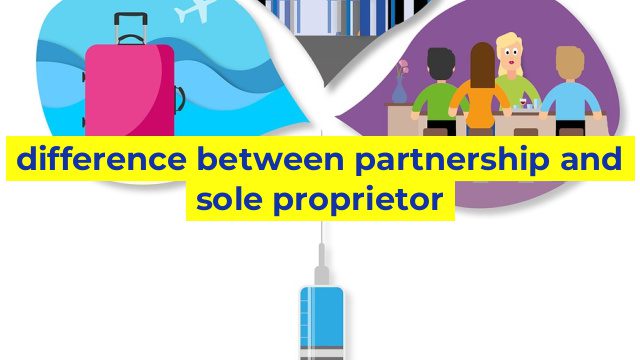The Key Differences between Partnership and Sole Proprietorship
When starting a new business, the legal structure you choose is crucial to its success. Two popular options are partnership and sole proprietorship. While both options have distinct advantages and disadvantages, understanding the key differences can help you to make the right decision for your business.
Sole Proprietorship
A sole proprietorship is a business owned and operated by a single person. This means that the owner retains complete control over the business and is responsible for all aspects of its operation. A sole proprietorship is not a separate legal entity from the owner, which means that the business income and losses are reported on the owner’s personal income tax return.
Partnership
A partnership is a business owned by two or more people. There are two types of partnerships: general and limited. In a general partnership, all partners share equal control of the business and are jointly liable for debts and legal issues. In a limited partnership, there is at least one general partner who assumes full liability and at least one limited partner who has limited liability.
Key Differences
The main difference between partnership and sole proprietorship is the number of people involved in the business. In a partnership, there are two or more individuals who share control, decision-making, and liabilities. In a sole proprietorship, the owner has complete control over the business and assumes all legal and financial responsibility.
Another key difference is the taxation of the business. In a sole proprietorship, the owner reports all business income and losses on their personal income tax return. In a partnership, the business must file an annual tax return, but the partners report their share of the profits and losses on their personal tax returns.
Lastly, partnerships are more complex in terms of legal structure and documentation. Partnerships require a written agreement that outlines the partners’ rights and responsibilities, the distribution of profits and losses, and the management of the business. Sole proprietorships, on the other hand, have minimal legal requirements and do not require any special documentation.
Conclusion
Choosing between a partnership and sole proprietorship will depend on various factors, including the nature of your business, the number of people involved, and your personal financial goals. It’s crucial to consider the advantages and disadvantages of each option carefully. By understanding the key differences between the two, you can make the right decision for your business and set yourself up for success in the long term.
Table difference between partnership and sole proprietor
| Partnership | Sole Proprietor | |
|---|---|---|
| Definition | A business arrangement between two or more individuals who share profits and losses. | A business owned and operated by a single individual. |
| Legal Entity | Considered a separate legal entity from its owners. | Not a separate legal entity from its owner. |
| Liability | The partners are liable for the debts and obligations of the partnership. | The sole proprietor is personally liable for the debts and obligations of the business. |
| Management | The partners share the management and decision-making responsibilities. | The sole proprietor makes all management and decision-making decisions. |
| Taxation | The partnership’s profits are taxed as personal income of the partners. | The sole proprietor reports profits and losses on their personal tax return. |
| Capital | Partners contribute capital to the business and share in the profits and losses. | The sole proprietor is responsible for providing all the capital for the business. |

